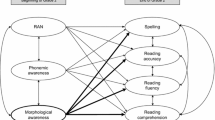Abstract
In order to investigate the relationship between oral language usage and morphological awareness, 5- to 7-year-old children with specific language impairment (SLI) were compared to age-matched (AM) and language-matched (LM) comparison groups on a variety of measures requiring metalinguistic skill. These included sentence completion (involving real and nonsense words); comprehension of inflected non-words; response to morphological errors (including judgment, identification, and repair), and deliberate creation of grammatical violations. Overall, the SLI children performed significantly worse than their AM peers and were indistinguishable from younger LM children, suggesting that morphological awareness is more closely allied with oral language than with general cognitive/chronological development.
Similar content being viewed by others
References
Berko, J. 1958. The children’s learning of English morphology.Word 14:150–77.
Berry, M.F., and Talbot, R. 1966.Berry-Talbot Language Tests: Comprehension of Grammar. Rockford IL.
Borkowski, J.G., Ryan, E.B., Kurtz, B.E., and Reid, M.K. 1983. Metamemory and metalinguistic development: Correlates of children’s intelligence and achievement.Bulletin of the Psychonomic Society 21:393–96.
Bowey, J.A. 1988.Metalinguistic Functioning in Children. Victoria, Australia: Deakin University Press.
Bradley L., and Bryant, P. 1983. Categorizing sounds and learning to read: A causal connection.Nature 3012:419–21.
Brown, R. 1973.A First Language: The Early Stages. Cambridge, MA: Harvard University Press.
Carlisle, J. (1988). Knowledge of derivational morphology and spelling ability in 4th, 6th and 8th graders.Applied Psycholinguistics 9:247–66.
Cazden, C.B. 1968. The acquisition of noun and verb inflections.Child Development 39:433–88.
Clark, E. 1978. Awareness of language: Some evidence from what children say and do. InThe Child’s Conception of Language, eds. A. Sinclair, R.J. Jarvella, and W.J.M. Levelt. Berlin: Springer-Verlag.
Chaney, C. 1992. Language development, metalinguistic skills, and print awareness in 3-year-old children.Applied Psycholinguistics 13:485–514.
Chaney, C. 1994. Language development, metalinguistic awareness, and emergent literacy skills of 3-year-old children in relation to social class.Applied Psycholinguistics 15:371–94.
deVilliers, J., and deVilliers, P. 1974. Competence and performance in child language: Are children really competent to judge?Journal of Child Language 1:11–22.
deVilliers, J., and deVilliers, P. 1978.Language Acquisition. Cambridge MA: Harvard University Press.
Gopnik, M., and Crago, M. 1991. Familial aggregation of a developmental language disorder.Cognition 39:1–50.
Hakes, D. 1982. The development of metalinguistic abilities: What develops? InLanguage Acquisition: Language, Cognition and Culture. ed. S.A. Kuczaj II. Hillsdale NJ: Lawrence Erlbaum.
Johnston, J.R., and Schery, T.K. 1976. The use of grammatical morphemes by children with communication disorders. InNormal and Deficient Child Language, eds. D. Morehead and A. Morehead. Baltimore MD: University Park Press.
Kamhi, A.G., and Koenig, L.A. 1985. Metalinguistic awareness in normal and language-disabled children.Language, Speech and Hearing Services in the Schools 16:199–210.
Kujcaz, S.A. 1977. The acquisition of regular and irregular past tense forms.Journal of Verbal Learning and Verbal Behavior 16:589–600.
Leonard, L. 1989. Language learnability and specific language impairment in children.Applied Psycholinguistics 10:179–202.
Leonard, L., Bortolini, U., Caselli, M.C., McGregor, K.K., and Sabbadini, L. 1992. Morphological deficits in children with SLI: The status of features in the underlying grammar.Language Acquisition 2:151–79.
Loeb, D., and Leonard, L. 1991. Subject case marking and verb morphology in normally developing and specifically language impaired children.Journal of Speech and Hearing Research 34:340–46.
Liberman, I.Y., Shankweiler, D., Fischer, F.W., and Carter, B. (1974). Explicit syllable and phoneme segmentation in the young child.Journal of Experimental Child Psychology 18:201–12.
Liberman, I.Y., Shankweiler, D., Liberman, A.M., Fowler, C., and Fischer F.W. 1977. Phonetic segmentation and recoding in the beginning reader. InToward a Psychology of Reading, eds. A.S. Reber and D.L. Scarborough. Hillsdale NJ: Lawrence Erlbaum.
Marcus, G., Pinker, S., Ullman, M., Hollander, M., Rosen, T.J., and Xu, F., 1992.Overregularization in Language Acquisition. Monographs of the Society for Research in Child Development, 57(228).
Marshall, J.C., and Morton, J., 1978. On the mechanics of EMMA. InThe Child’s Conception of Language, eds. A. Sinclair, R.J. Jarvella, and W.J.M. Levelt. Berlin: Springer-Verlag.
Morais, J., Cary, L., Alegria, J., and Bertelson, P. 1979. Does awareness of speech as a sequence of phones arise spontaneously?Cognition 7:323–31.
Rice, M., Wexler, K., and Cleave, P. 1995. Specific language impairment as a period of Extended Optional Infinitive.Journal of Speech and Hearing Research 38:850–63.
Rubin, H. 1988. Morphological knowledge and early writing ability.Language and Speech 31:337–55.
Rubin, H., Kantor, M., and MacNab, J. 1990. Grammatical awareness in the spoken and written language of language-disabled children.Canadian Journal of Psychology 44:483–500.
Rubin H., Mallory, S., Farndale, D., Howe T., and Ramdeholl, S. (unpublished study). The development of language analysis in young children. University of Toronto and Haskins Laboratories.
Saywitz, K., and Wilkinson, L.C. 1982. Age-Related Differences in Metalinguistic Awareness. InLanguage Acquisition: Language, Cognition and Culture, ed. S.A. Kuczaj II. Hillsdale NJ: Lawrence Erlbaum.
Scarborough, H.S., Rescorla, L., Tager-Flusberg, H., Fowler, A.E., and Sudhalter, V. 1991. The relation of utterance length to grammatical complexity in normal and language-disordered groups.Applied Psycholinguistics 12:23–45.
Shipley, K.G., Maddox, M.A., and Driver, J.E., 1991.Children’s Development of Irregular Past Tense Verb Forms. Language Speech and Hearing Services in Schools 22:115–22.
Slobin, D. 1971. On the learning of morphological rules: A reply to Palermo and Eberhart. InThe Ontogenesis of Grammar, D. Slobin ed. New York: Academic Press.
Smith, C.L., and Tager-FLusberg, H. 1982. Metalinguistic awareness and language development.Journal of Experimental Child Psychology 34:449–68.
Smith-Lock, K.M., and Rubin, H. 1993. Phonological and morphological analysis skills in young children.Journal of Child Language 20:437–54.
Steckol, K.F., and Leonard, L.B. 1979. The use of grammatical morphemes by normal and language-impaired children.Journal of Communication Disorders 12:291–301.
Tunmer, W.E., and Bowey, J.A. 1984. Metalinguistic Awareness and Reading Acquisition. InMetalinguistic Awareness in Children, eds. W.E. Tunmer, C. Pratt, and M.L. Herriman. Berlin: Springer-Verlag.
Van Kleek, A. 1982. The emergence of linguistic awareness: A cognitive framework.Merrill-Palmer Quarterly 28:437–443.
Wechsler, D. 1989.Wechsler Preschool and Primary Scale of Intelligence-Revised. San Antonio, TX: The Psychological Corporation.
Author information
Authors and Affiliations
Rights and permissions
About this article
Cite this article
Smith-Lock, K.M. Morphological usage and awareness in children with and without specific language impairment. Annals of Dyslexia 45, 161–185 (1995). https://doi.org/10.1007/BF02648217
Issue Date:
DOI: https://doi.org/10.1007/BF02648217



